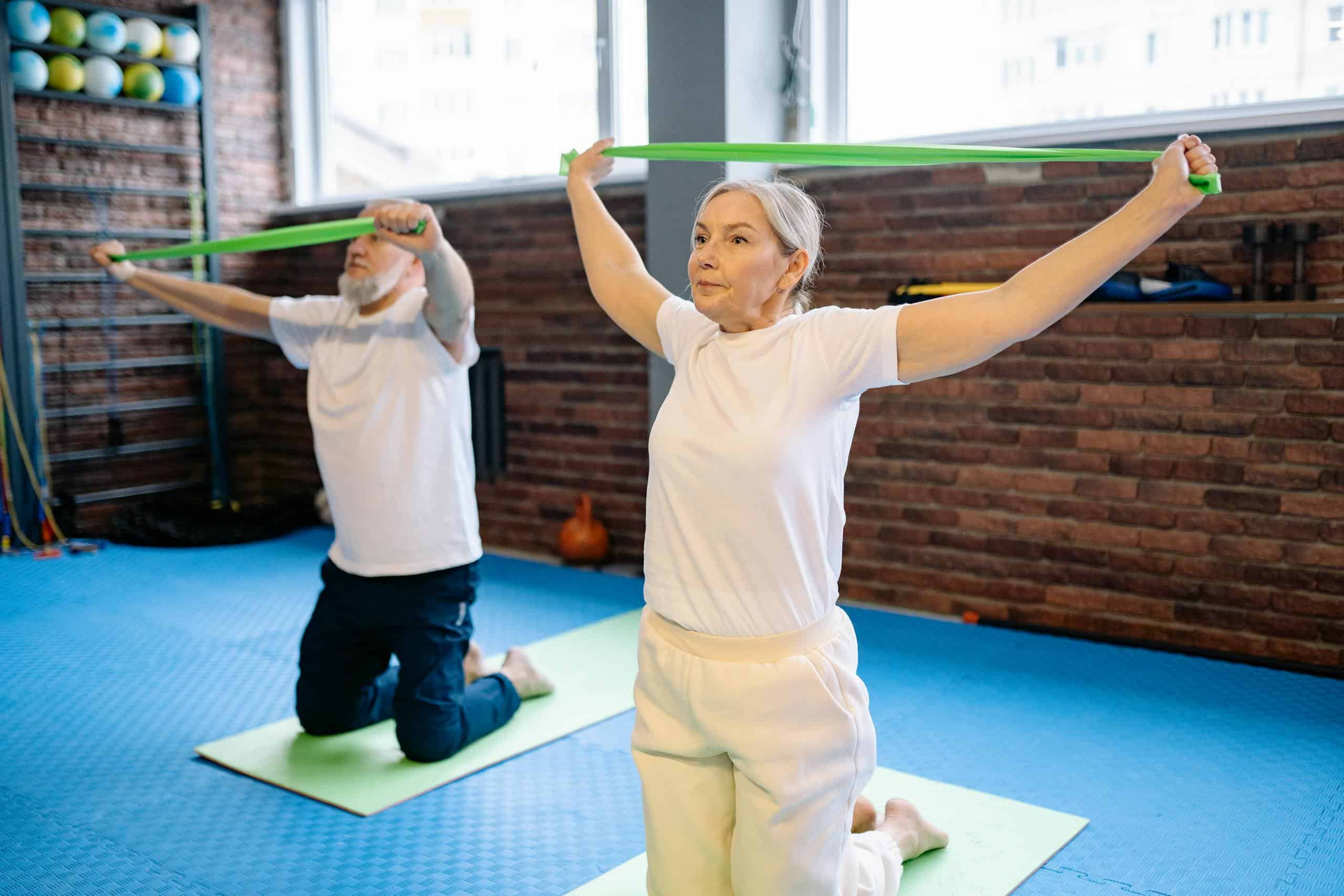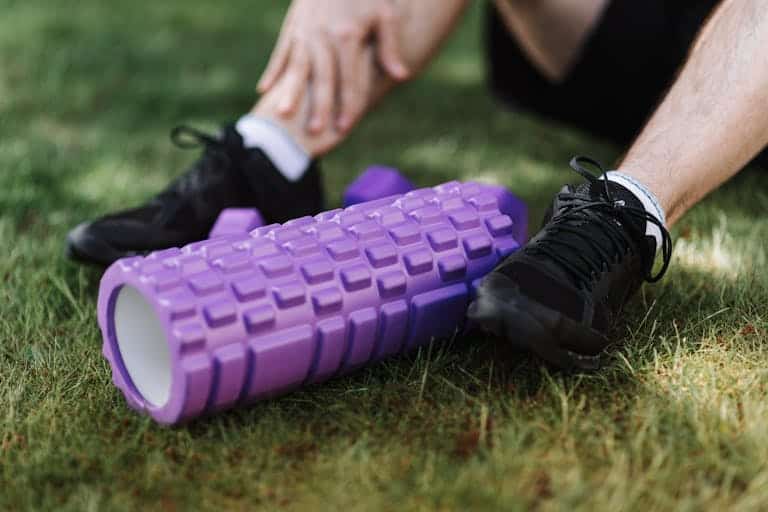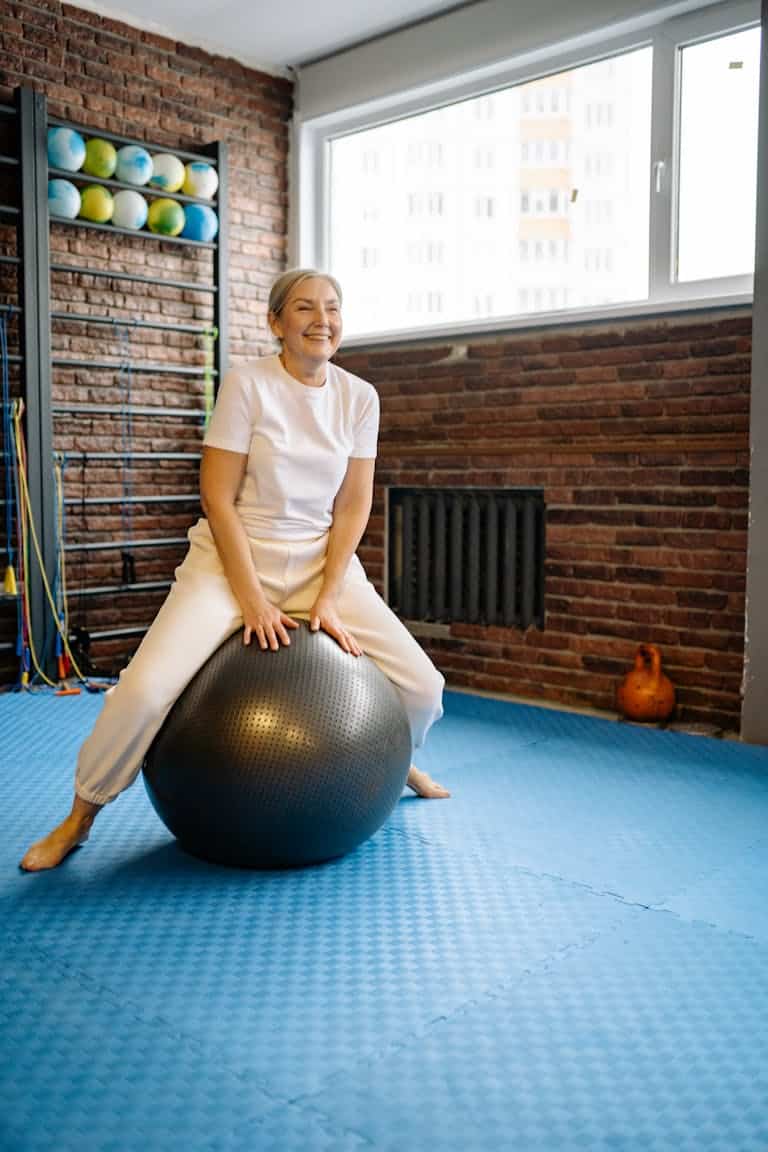5 Best Senior Strength Training Bands for Safe Workouts
Disclosure: My rankings are meticulously crafted using advanced algorithms that analyze a vast number of customer reviews, assessing everything from product quality and brand reputation to customer service and popular trends. While these rankings are based on my independent evaluations and intended to serve as a helpful starting point for your shopping journey, it’s worth noting that by purchasing through my recommendations, you’ll access the best prices I’ve found. Additionally, I may earn a commission at no extra cost to you, which supports my ability to continue offering valuable insights.
Table of Contents
Introduction
“Strength does not come from physical capacity. It comes from an indomitable will.” – Mahatma Gandhi
As we age, staying active is essential for maintaining both our independence and overall health. Resistance bands are a fantastic tool for seniors to build strength safely, without the need for heavyweights or complicated equipment. If you’re looking to stay fit or help a loved one do so, you’re in the right place! In this article, I’ll be sharing my personal experiences using these versatile bands, along with my top picks for the best resistance bands for senior strength training.
And hey, if you’re just starting out on your fitness journey or you’re looking for a more comprehensive guide, check out my Ultimate Guide to Active Aging and Physical Fitness for Seniors, where I cover everything you need to know about staying fit in your golden years.
Why Seniors Should Use Resistance Bands for Strength Training
As we get older, finding a workout that’s easy on the body but still effective can be a challenge. That’s where resistance bands come in! They’re not only gentle on aging joints but also super convenient and versatile. From my experience, they’re the perfect solution for seniors who want to stay strong and active without putting unnecessary strain on their bodies. Let me share why I think resistance bands are a must-have for anyone in their golden years looking to build strength.
Gentle on Joints
One of the best things about resistance bands is that they provide a low-impact workout, making them ideal for seniors dealing with joint pain or arthritis. I’ve had clients who struggled with traditional weights because of stiffness or soreness, but when they switched to resistance bands, they were able to get a good workout without discomfort. If joint pain is something you deal with, check out my post on how to modify common exercises for seniors with arthritis for more tips on making exercises gentler on your body.
Research backs this up too. A study by Stojanović et al. (2021) found that using low-load resistance bands significantly improves functional fitness and metabolic health markers in seniors, like grip strength and blood sugar levels. So, if you’re looking for a way to safely boost your strength without aggravating your joints, resistance bands are an excellent option! (Stojanović et al., 2021).
Portable and Affordable
Another major perk of resistance bands is that they’re incredibly portable and affordable. You can toss them in a drawer or even take them with you when you travel. And let’s face it, fitness equipment can get pricey, but resistance bands are budget-friendly and still deliver results. If you’re building a home gym or just want something that doesn’t take up space, check out my guide on creating a budget-friendly home gym for seniors for more tips on setting up your space without breaking the bank.
Adaptable for All Fitness Levels
What I love most about resistance bands is how adaptable they are. Whether you’re just starting out or you’ve been working out for years, you can easily adjust the tension to match your strength level. When I first began incorporating bands into my routine, I started with the lightest resistance and gradually worked my way up. It’s great because you don’t have to buy new equipment as you get stronger — just switch up the bands or add more tension!
Promotes Full-Body Strength
Unlike traditional weights, resistance bands engage multiple muscles at once, especially the stabilizer muscles that are so important for balance. For seniors, this is a game-changer because improving balance means reducing the risk of falls. That’s a big deal when it comes to maintaining independence as we age. Resistance bands are a fantastic way to get a full-body workout, targeting both large and small muscles, which helps with everything from coordination to everyday tasks.
By the way, if you’re interested in improving your balance further, take a look at my post on exercises to boost balance and coordination for more tips on staying steady on your feet.
What to Look for in Senior Strength Training Bands
When it comes to picking out the right resistance bands for senior strength training, there are a few key factors to keep in mind. From personal experience, I’ve seen how important it is to choose bands that not only meet your current fitness level but also grow with you as you get stronger. Here are some of the things I always recommend to look for:
Variety of Resistance Levels
One of the best features of resistance bands is how customizable they are. Look for a set that offers a range of resistance levels, from light to heavy. This way, as your strength improves, you can gradually increase the intensity of your workouts without having to buy new equipment. A lot of the seniors I work with find it super helpful to start with the lightest tension and then work their way up. It’s a great way to see progress and stay motivated.
Non-Slip Material
The last thing you want is a resistance band slipping out of your hands or off your feet mid-exercise! That’s why it’s important to choose bands that have a non-slip grip. This is especially crucial for seniors who might have a little less dexterity. Look for bands with a textured surface or reinforced handles for a more secure grip.
Durability and Safety
Quality is key when it comes to resistance bands. Poorly made bands can snap, and no one wants to risk an injury while working out. It’s worth investing in durable, well-made bands that will last you a long time. Personally, I always recommend buying from trusted brands that are known for their safety standards. If you’re just starting your strength training journey, safety should be your top priority.
For more tips on finding the right fitness gear, check out my posts on the best 15 yoga mats for seniors and top 5 joint-friendly workout equipment. These guides offer some fantastic recommendations to help you stay safe and comfortable while working out.
Tailoring Your Bands to Specific Health Needs
For seniors managing specific health conditions like type 2 diabetes, resistance training with elastic bands can be particularly beneficial. According to a study by Yamamoto et al. (2020), resistance training using elastic bands improved muscle strength, especially in the lower body, for elderly patients with diabetes. This just goes to show that picking the right bands that cater to your health needs can make a real difference in your strength and fitness journey. (Yamamoto et al., 2020)
By choosing bands that offer a variety of resistance levels and ensuring they’re durable and safe, you’re setting yourself up for long-term success. And remember, it’s all about starting where you’re comfortable and gradually working your way up as your strength improves.
Top 5 Senior Strength Training Bands for Safe Workouts
Resistance bands have become an essential tool for seniors who want to improve strength, flexibility, and overall fitness without putting too much strain on their joints. With so many different types of bands on the market, it can be tricky to figure out which ones are the best fit. In this section, I’ll dive into the top five senior strength training bands, exploring their features, customer feedback, and ideal use cases. Whether you’re looking for something simple and portable or a more customizable full-body workout, there’s a band here to match your needs.
1. TheraBand Resistance Bands

- Features: Latex-free, comes in various resistance levels, durable, widely recommended by physical therapists.
- Pros:
- Gentle on joints, ideal for seniors.
- Available in different resistance levels for gradual progression.
- High durability; lasts long without snapping.
- Endorsed by healthcare professionals, particularly for rehabilitation.
- Cons:
- Some users reported a lack of grip, making them harder to use when hands get sweaty.
- Slightly more expensive compared to similar products.
- Best For: Seniors looking for a gentle but effective full-body workout, and those recovering from injuries.
- Price Range: $12–$25
- Rating: ★★★★☆ (4.6/5)
- Summary: TheraBand resistance bands are highly reliable and effective for seniors, especially for those in physical therapy or anyone looking for a low-impact strength-building option. While some users mention that the bands can get slippery, their overall durability and ease of use make them a top choice for senior fitness.
2. Fit Simplify Resistance Loop Bands

- Features: Set of 5 bands with different resistance levels, compact, made from high-quality rubber.
- Pros:
- Extremely portable and lightweight, perfect for travel.
- Ideal for targeting lower body muscles (glutes, thighs).
- Comes with a handy carrying pouch and instructional guide.
- Cons:
- Some users complained about the bands rolling up during use, especially on bare skin.
- Not as durable as thicker resistance bands; they might snap with heavy use.
- Best For: Seniors looking for a portable solution, especially for lower body workouts and physical therapy.
- Price Range: $10–$20
- Rating: ★★★★☆ (4.2/5)
- Summary: Fit Simplify Resistance Loop Bands are compact, making them excellent for on-the-go use. While they are versatile, especially for targeting the lower body, durability issues have been reported after long-term use. They’re best for seniors looking for a lightweight option to add variety to their routine.
3. Bodylastics Stackable Tube Resistance Bands

- Features: Stackable bands for added resistance, includes safety clips to prevent overstretching.
- Pros:
- Allows users to customize the resistance by stacking bands.
- Safety clips provide peace of mind, reducing the risk of the bands snapping during exercise.
- Comes with a wide range of accessories (door anchors, handles) for full-body workouts.
- Cons:
- Some users find the attachments (handles and anchors) difficult to adjust or uncomfortable to use.
- Higher price point compared to simpler resistance bands.
- Best For: Seniors who want to gradually increase workout intensity and enjoy a customizable full-body workout.
- Price Range: $30–$50
- Rating: ★★★★☆ (4.5/5)
- Summary: Bodylastics Stackable Tube Resistance Bands stand out for their versatility and safety. With the ability to stack bands for added resistance, they’re great for seniors who want to increase workout intensity. However, some may find the attachments tricky, so they’re best suited for those comfortable with adjustments during workouts.
4. Whatafit Resistance Bands Set
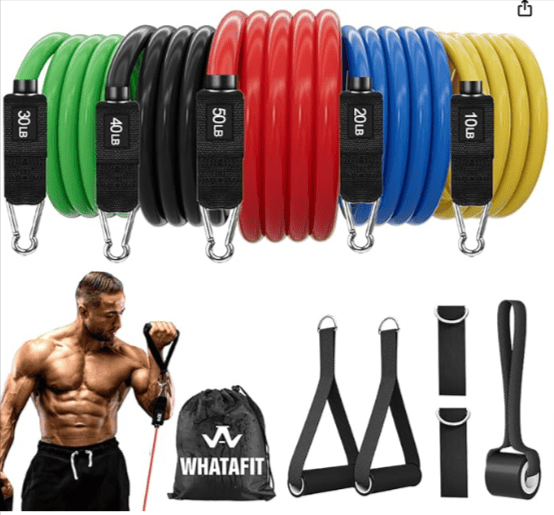
- Features: Includes handles, ankle straps, door anchors, and five bands of varying resistance.
- Pros:
- Offers a complete workout package with multiple accessories.
- Suitable for full-body workouts, including legs, arms, and core.
- Easy to use at home with the door anchor setup.
- Cons:
- Several users reported the door anchor wearing out after prolonged use.
- Handles can become uncomfortable during extended workouts.
- Best For: Seniors looking for an all-in-one set for home workouts that target the entire body.
- Price Range: $25–$40
- Rating: ★★★★☆ (4.4/5)
- Summary: The Whatafit Resistance Bands Set is a versatile home workout kit, especially for seniors who prefer to exercise at home. While it offers great value with its range of accessories, users have noted some wear and tear on the door anchor over time.
5. WODFitters Pull-Up Assistance Bands
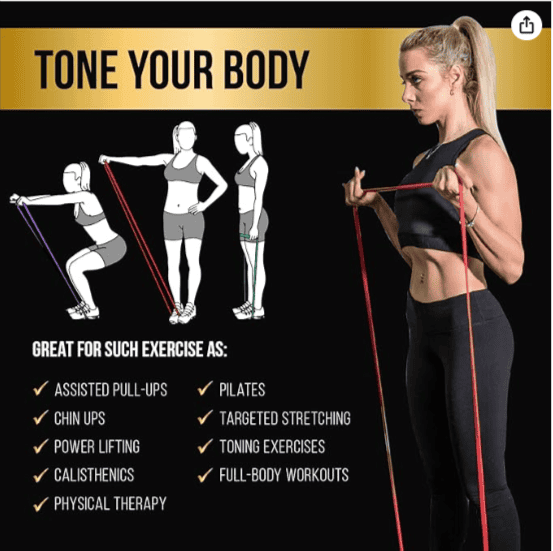
- Features: Heavy-duty bands available in a variety of resistance levels, initially designed for pull-ups but versatile for strength training.
- Pros:
- Extremely durable and designed to withstand heavy use.
- Perfect for seniors looking to build strength in larger muscle groups.
- Available in a wide range of resistance levels, from light to very heavy.
- Cons:
- Heavier resistance bands may be difficult for beginners or those with less upper body strength.
- Larger bands can feel bulky for smaller or more precise exercises.
- Best For: Seniors looking for heavy-duty bands to target larger muscle groups or those transitioning from beginner to more advanced strength training.
- Price Range: $20–$60
- Rating: ★★★★☆ (4.3/5)
- Summary: WODFitters Pull-Up Assistance Bands are perfect for seniors looking to focus on larger muscle groups and overall strength. Their durability makes them ideal for long-term use, but they may feel bulky for those new to resistance bands or for smaller muscle group exercises.
Top 2 Recommendations:
- TheraBand Resistance Bands
- These bands are a fantastic option for seniors seeking a safe, effective, and durable product to enhance strength without stressing their joints. The endorsement from physical therapists and the wide range of resistance levels make them a standout.
- Bodylastics Stackable Tube Resistance Bands
- Ideal for seniors who want more versatility and customization in their workouts. The ability to stack bands for different resistance levels and the inclusion of safety clips ensures safe, progressive strength training for all fitness levels.
Summary
Resistance bands are an excellent choice for seniors looking to maintain or improve muscle strength safely. From portable loop bands to more versatile, stackable options, these tools can be tailored to fit any fitness level. As research shows, even very elderly adults can experience significant gains in muscle size and strength through consistent resistance training with bands. A systematic review by Grgic et al. (2020) found that resistance training, including elastic bands, is highly effective for maintaining muscle strength in older adults, making it a valuable addition to any senior workout routine. So, whether you’re just starting or looking to take your training to the next level, the right resistance band can make all the difference.
Simple Resistance Band Exercises for Seniors
When it comes to staying strong and active, resistance bands are not only effective but also incredibly easy to use. Even if you’re new to strength training, you can start with a few simple exercises and gradually build your confidence and stamina. Below are some of my favorite resistance band exercises for seniors—each one chosen for its simplicity, safety, and effectiveness in targeting key muscle groups. Plus, these exercises are perfect for doing at home with minimal equipment!
Seated Rows
If you’re looking to strengthen your back and shoulders without standing up, seated rows are a fantastic option. Just sit on a chair, loop the band around your feet, and pull it toward you, keeping your back straight. This exercise is perfect for improving posture and back strength—two areas that often need attention as we age.
Pro tip: If you find your muscles are a bit stiff, you might want to try a few chair yoga poses for seniors before you begin. Loosening up your muscles can make this exercise even more effective and comfortable.
Bicep Curls
Ah, the classic bicep curl! This exercise never goes out of style because it’s such an effective way to maintain arm strength. Strong arms help with everyday tasks, like carrying groceries or even just lifting a cup of coffee. To perform, step on the band with both feet, hold the ends in your hands, and curl your arms up toward your shoulders.
As you start to feel stronger, you can increase the resistance by either shortening the band or moving up to a band with higher tension. Simple, but so effective!
Leg Presses
I love leg presses because they target your quads and hamstrings—key muscles that help with walking and standing. For this one, sit on a chair, loop the band around your feet, and press your legs out in front of you. Start with light resistance, and as you build strength, increase the tension by shortening the band or using a heavier resistance band.
This exercise is also fantastic for improving leg endurance, so you’ll find yourself feeling steadier when walking or climbing stairs. For seniors looking to maintain strong legs, this is a must.
Lateral Band Walks
If balance and coordination are areas you’re looking to improve, lateral band walks are perfect for you. Simply loop a resistance band around your legs just above your knees, and take small steps to the side. You’ll feel this one working your hips and legs, and it’s great for stabilizing your lower body.
I recommend pairing this exercise with a few movements from my post on exercises to boost balance and coordination. Together, they’ll give you a well-rounded routine that helps improve your stability and prevent falls—a key concern for many seniors.
Resistance band exercises don’t have to be complicated to be effective. These simple movements can go a long way in keeping your muscles strong, improving balance, and supporting your overall mobility. As research suggests, resistance training—even with basic tools like elastic bands—can significantly improve muscle size and strength, even in the very elderly (Grgic et al., 2020). So whether you’re just starting out or have been training for years, these exercises are a fantastic way to stay strong and healthy.
Tips for Safe and Effective Senior Workouts
When it comes to working out as a senior, safety is key. Strength training, especially with resistance bands, can do wonders for your health, but it’s important to approach it the right way. Whether you’re just starting or have been exercising for a while, these tips will help ensure your workouts are both safe and effective.
Start Slow
One of the biggest mistakes I’ve seen people make (and I’ve been guilty of this too!) is jumping into a new routine too quickly. If you’re new to strength training, especially with resistance bands, it’s essential to ease into it. Start with short, gentle sessions and choose lighter resistance bands to get your body used to the movements.
You don’t need to rush to see progress. Consistency is what matters most, and by starting slow, you’ll avoid the risk of overdoing it and potentially hurting yourself. This is especially important for seniors, as muscles and joints may take a bit longer to adapt. As I always say, slow and steady wins the race when it comes to fitness!
Focus on Form
Proper form is everything when it comes to exercise. Not only does good form help you get the most out of each movement, but it also prevents injuries. When using resistance bands, it’s tempting to rush through exercises, but trust me—taking your time will make a huge difference. Perform each movement slowly and focus on how your muscles feel as you work through the exercise.
If you’re unsure about your form, consider following along with an instructional video or getting feedback from a personal trainer. Poor technique increases the risk of strain or injury, so it’s worth investing the time to get it right. A good form today can save you a lot of pain tomorrow!
Rest and Recover
I cannot stress this enough: listen to your body. One of the things I’ve learned over the years is that rest days are just as important as workout days. It’s during your rest that your muscles recover and grow stronger, so make sure to schedule in those well-earned breaks.
Rest doesn’t mean being inactive, though. On your rest days, you can incorporate some light safe stretching for seniors to keep your muscles flexible and prevent injury. Stretching is an excellent way to enhance your range of motion and maintain your mobility without putting too much strain on your body. So, take your recovery seriously—it’s all part of the process!
Strength training is an incredibly beneficial activity for seniors, but it’s important to approach it with care and patience. Whether you’re just getting started or looking to fine-tune your routine, keeping these tips in mind will help you stay safe and get the most out of your workouts. After all, fitness is a marathon, not a sprint!
Conclusion
“We don’t stop exercising because we grow old; we grow old because we stop exercising.” – Dr. Kenneth Cooper
Strength training with resistance bands is one of the safest and most effective ways to maintain and build muscle as you age. By incorporating these simple tools into your fitness routine, you can continue to enjoy an active, independent life. If you’re interested in learning more ways to stay fit, be sure to explore my post on strength training for seniors for more detailed workout ideas and tips on building muscle after 60!
And don’t forget: staying active isn’t just about strength, it’s about your overall well-being. For a full picture of maintaining fitness as you age, make sure to read my Ultimate Guide to Active Aging and Physical Fitness for Seniors.
References:
- Stojanović, M., Mikić, M., Milošević, Z., Vukovic, J., Jezdimirović, T., & Vučetić, V. (2021). Effects of chair-based, low-load elastic band resistance training on functional fitness and metabolic biomarkers in older women. Journal of Sports Science & Medicine, 20(1), 133–141. https://doi.org/10.52082/jssm.2021.133
- Yamamoto, Y., Nagai, Y., Kawanabe, S., Hishida, Y., Hiraki, K., Sone, M., & Tanaka, Y. (2020). Effects of resistance training using elastic bands on muscle strength with or without a leucine supplement for 48 weeks in elderly patients with type 2 diabetes. Endocrine Journal. https://doi.org/10.1507/endocrj.EJ20-0550
- Grgic, J., Garofolini, A., Orazem, J., Sabol, F., Schoenfeld, B., & Pedišić, Ž. (2020). Effects of resistance training on muscle size and strength in very elderly adults: A systematic review and meta-analysis of randomized controlled trials. Sports Medicine, 50, 1983–1999. https://doi.org/10.1007/s40279-020-01331-7

